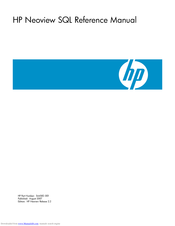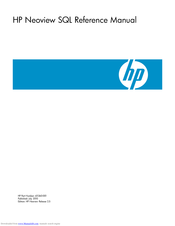Hp Neoview SQL Manuals
Manuals and User Guides for Hp Neoview SQL. We have 2 Hp Neoview SQL manuals available for free PDF download: Reference Manual
Hp Neoview SQL Reference Manual (462 pages)
Table of Contents
-
-
SQL Language29
-
Security29
-
-
Lock Mode31
-
Lock Holder32
-
-
Concurrency33
-
-
-
Categories41
-
-
Joins64
-
-
Disk Pool77
-
-
-
Syntax104
-
Considerations105
-
GRANT Statement115
-
INSERT Statement121
-
REVOKE Statement134
-
SELECT Statement141
-
-
Locking Modes151
-
Join Limits152
-
UPDATE Statement169
-
-
3 SQL Utilities
181-
MAINTAIN Command182
-
-
Character Sets190
-
Columns191
-
Constraints193
-
Database Objects195
-
Ownership195
-
-
Data Types197
-
Expressions208
-
Identifiers220
-
Indexes221
-
SQL Indexes221
-
-
Keys222
-
Clustering Keys222
-
Index Keys222
-
SQL Index Keys222
-
-
Primary Keys222
-
-
Literals223
-
Numeric Literals228
-
Null230
-
Predicates233
-
EXISTS Predicate238
-
IN Predicate239
-
Examples of in240
-
NULL Predicate241
-
Privileges245
-
Schemas247
-
Search Condition248
-
Subquery250
-
Tables252
-
Triggers253
-
Views254
-
Advertisement
Hp Neoview SQL Reference Manual (552 pages)
Table of Contents
-
-
SQL Language25
-
Security25
-
-
Lock Mode27
-
Lock Holder27
-
-
-
Categories37
-
-
DELETE Statement108
-
GRANT Statement136
-
INSERT Statement144
-
REVOKE Statement156
-
-
SELECT Statement164
-
TABLE Statement197
-
UPDATE Statement198
-
VALUES Statement210
-
-
3 SQL Utilities
211-
MAINTAIN Command212
-
-
Character Sets234
-
Columns235
-
Constraints237
-
Cursors239
-
Database Objects241
-
Ownership241
-
-
Data Types243
-
Expressions255
-
Identifiers269
-
Indexes271
-
SQL Indexes271
-
-
Keys272
-
Clustering Keys272
-
Syskey272
-
Index Keys273
-
Primary Keys273
-
-
Literals274
-
Mvgroups282
-
Null283
-
Partitions285
-
Predicates286
-
EXISTS Predicate291
-
IN Predicate292
-
LIKE Predicate294
-
NULL Predicate296
-
Privileges301
-
Considerations301
-
-
Schemas304
-
Search Condition305
-
Subquery307
-
Synonyms309
-
Tables310
-
Triggers311
-
Views312
-
SQL Views312
-
-
-
5 SQL Clauses
313-
DEFAULT Clause314
-
FORMAT Clause316
-
SAMPLE Clause318
-
TRANSPOSE Clause329
-
Advertisement

